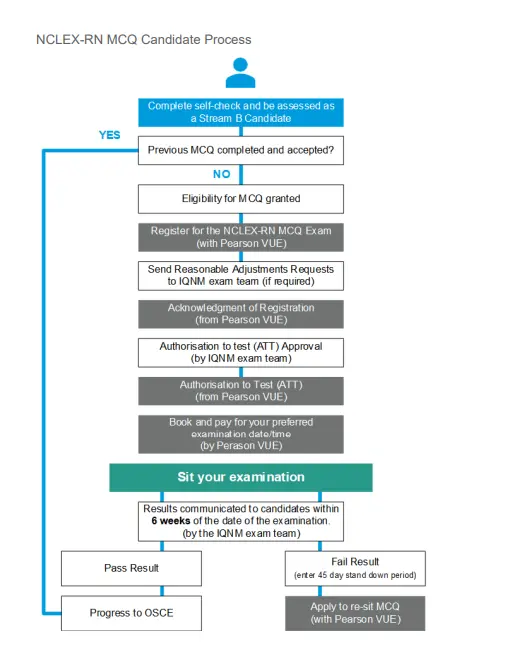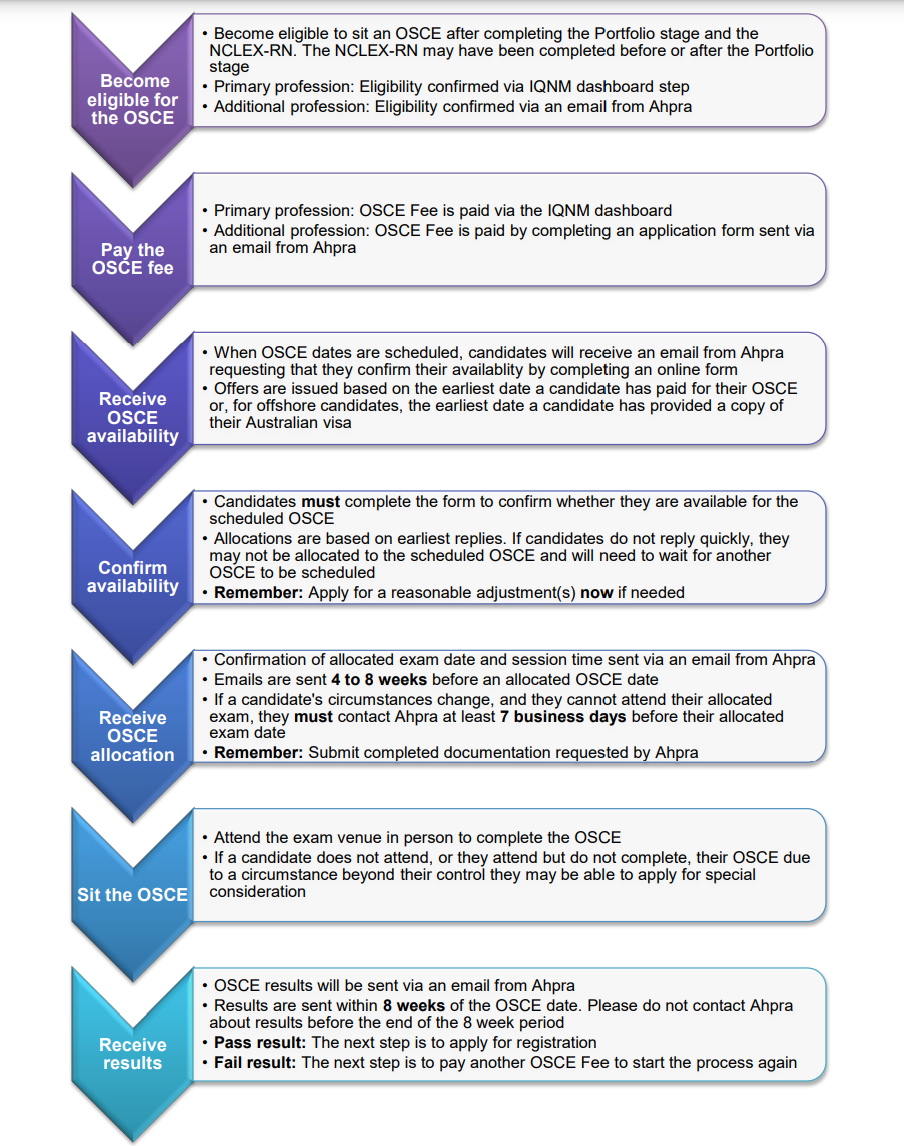International Nurses Guide to Registering in Australia
Self-Check: Before You Begin
- Qualifications:
- Ensure your nursing qualifications align with Australian standards.
- English Proficiency:
- Confirm that you meet the English language proficiency requirements.
- Work Visa:
- Research the appropriate visa options suitable for your circumstances.
- Professional Experience:
- Document your nursing experience and professional history.
Checklist for Registration
Step 1: Determine Eligibility
- Ensure you meet the following criteria:
- Hold a valid nursing qualification from a recognized institution.
- Have a minimum English language proficiency.
Step 2: English Language Proficiency To register as a nurse in Australia, you must demonstrate your English language skills. Acceptable tests and minimum scores include:
- International English Language Testing System (IELTS)
- Minimum overall score of 7.0
- No individual band score lower than 7.0
- Occupational English Test (OET)
- Pass in all four components: listening, reading, writing, and speaking with a grade of at least 'B'.
- Pearson Test of English (PTE) Academic
- Minimum score of 65, with no communicative skills score lower than 65.
- Test of English as a Foreign Language (TOEFL) iBT
- Minimum total score of 94
- Minimum scores of 24 in listening, 24 in reading, 27 in writing, and 23 in speaking.
- Cambridge English: Advanced (CAE)
- Minimum score of 185 with no component lower than 185.
- Cambridge English: Proficiency (CPE)
- Minimum score of 200 with no component lower than 200.
- University of Cambridge English Language Assessment
- Overall score of 185 with no less than 185 in each component.
Resources:
- IELTS Australia
- Occupational English Test (OET)
- Pearson Test of English (PTE) Academic
- TOEFL iBT
- Cambridge English
Step 3: Obtain an Australian Nursing Qualification
- If your qualifications are not recognised, enrol into the Outcome based assessment with OBA Nursing Academy to complete a bridging program.
Step 4: Apply for Registration with NMBA
- Prepare Documents:
- Proof of identity (passport or birth certificate).
- Nursing qualification certificates and transcripts.
- Evidence of professional practice (CV/resume).
- English language proficiency test results.
- Criminal history checks (if required).
- Create an Account:
- Register on the Australian Health Practitioner Regulation Agency (AHPRA) website.
- Submit Application:
- Complete the online registration application.
- Select the appropriate type of registration (Registered Nurse, Enrolled Nurse, etc.).
- Pay Registration Fees:
- Application Fee: AUD $410
- Annual Registration Fee: AUD $185
- OSCE Fee (if applicable): AUD $4,000 (for overseas applicants required to complete the Objective Structured Clinical Examination)
- AHPRA Fees
- Fees are subject to change; check the AHPRA website for the most current fees.
Step 5: Complete Criminal History Check
- Provide a criminal history check from every country where you have lived for more than six months in the past 10 years.
Resources:
Step 6: Obtain a Visa
- Apply for a suitable visa to work in Australia. Common options for nurses include:
- 482 Temporary Skill Shortage Visa
- 407 Training Visa
Step 7: Prepare for the Transition
- Arrange accommodation, transportation, and other logistics for moving to Australia.
Step 8: Continuing Professional Development (CPD)
- Ensure you meet the NMBA's CPD requirements to maintain your registration.
Resources:
Fee Structure
| Description | Amount (AUD) |
|---|---|
| Application Fee | 410 |
| Annual Registration Fee | 185 |
| OSCE Fee (if required) | 4,000 |
| English Language Test (IELTS or OET) | 400 - 500 |
| Criminal History Check | Varies |
| Visa Application Fees (482/407) | Varies |
Useful Links
- AHPRA Registration: AHPRA Registration Information
- NMBA Guidelines: Nursing and Midwifery Board of Australia
- Visa Information: Department of Home Affairs

NCLEX-RN MCQ Candidate Process
The NCLEX-RN (National Council Licensure Examination for Registered Nurses) is a standardized exam for nursing licensure in the United States. It assesses a candidate's readiness to practice as a registered nurse (RN). Here is a streamlined overview of the candidate process:
1. Eligibility Requirements
- Education: Candidates must graduate from an accredited nursing program (Associate Degree in Nursing or Bachelor of Science in Nursing).
- Application: Submit an application for licensure to the nursing board in the state where you plan to practice.
2. Registration for the Exam
- Register with Pearson VUE: Create an account on the Pearson VUE website to register for the exam.
- Pay the Registration Fee: A non-refundable fee is required for registration, which varies by state.
3. Authorization to Test (ATT)
- After your application is processed, you will receive an ATT from your state board of nursing. This document allows you to schedule your NCLEX-RN exam.
4. Scheduling the Exam
- Select a Test Center: Choose a convenient test location from the available Pearson VUE test centers.
- Select a Date: Schedule your exam date, keeping in mind that the ATT is valid for a specific time frame.
5. Preparing for the Exam
- Study Resources: Utilize NCLEX review courses, practice questions, and study materials to prepare.
- Practice Tests: Take practice exams to familiarize yourself with the format and types of questions on the NCLEX-RN.
6. Taking the Exam
- Exam Format: The NCLEX-RN uses Computer Adaptive Testing (CAT), where the difficulty of questions adjusts based on your performance. The test consists of a minimum of 75 questions and a maximum of 145 questions, including multiple-choice, fill-in-the-blank, and hotspot questions.
- Exam Duration: Candidates have up to 5 hours to complete the exam, including breaks.
7. Receiving Results
- Official Results: After completing the exam, candidates receive a preliminary result indicating whether they passed or failed. Official results are typically available within a few days to weeks, depending on the state board.
8. Licensure
- Upon passing the NCLEX-RN, candidates can apply for licensure in their state, allowing them to practice as registered nurses.

Registered Nurse OSCE Candidate Process
The Objective Structured Clinical Examination (OSCE) is a critical assessment for international nurses seeking to gain registration as Registered Nurses in Australia. It evaluates clinical skills, knowledge, and the ability to provide safe patient care. Below is a streamlined overview of the OSCE candidate process:
1. Eligibility Requirements
- Educational Qualifications: Candidates must have completed a recognized nursing program equivalent to Australian standards.
- English Proficiency: A minimum score in an English language proficiency test (e.g., IELTS or OET) is required to demonstrate communication skills in a healthcare setting.
2. Application for Registration
- Apply to AHPRA: Submit an application for registration as a nurse with the Australian Health Practitioner Regulation Agency (AHPRA). This includes providing documentation of education, identity verification, and proof of English proficiency.
3. Registration Assessment
- Assessment by AHPRA: AHPRA reviews your application and may require additional documentation. Upon approval, candidates will receive an invitation to undertake the OSCE.
4. OSCE Registration
- Register for the OSCE: Once approved by AHPRA, candidates must register for the OSCE through an accredited assessment organization, such as the Australian Nursing and Midwifery Accreditation Council (ANMAC) or relevant testing centers.
5. Preparation for the OSCE
- Study and Practice: Candidates should prepare by reviewing clinical skills, guidelines, and assessment criteria. Many candidates benefit from practice sessions or workshops focused on OSCE scenarios.
- Resources: Utilize available study materials, including textbooks, online resources, and practice exams to enhance your knowledge and skills.
6. Taking the OSCE
- Exam Format: The OSCE consists of multiple stations where candidates must perform clinical tasks and demonstrate their skills. Each station is timed, and candidates are assessed on their ability to communicate, apply nursing procedures, and interact with patients.
- Scoring: Candidates are scored based on their performance, including assessment criteria such as clinical competence, communication, and professionalism.
7. Results and Feedback
- Receiving Results: Candidates typically receive their OSCE results shortly after completing the examination. Feedback may also be provided to help candidates improve in specific areas.
- Retaking the OSCE: If a candidate does not pass, they may be allowed to retake the OSCE. AHPRA will provide details on reapplication and retesting processes.
8. Registration as a Nurse
- Obtaining Registration: Upon passing the OSCE, candidates can proceed with their application for registration with AHPRA and receive their nursing license, enabling them to practice as Registered Nurses in Australia

RN OSCE Stations
The RN OSCE stations will be set up to reflect a range of care settings, including but not limited to:
- Hospital, either a ward or emergency department,
- General practice clinic,
- Aged care setting, or
- Community setting.
Patient types
A variety of patient types are used in the RN OSCE. The types of patients involved in each station will either be:
- A Simulated Patient, or
- A Manikin.
Smaller pieces of equipment may also be used to simulate part of a patient/person.
A scenario may also include both a Simulated Patient and a piece of equipment.
Whether a Simulated Patient or Manikin is used, it is essential that candidates demonstrate a level of empathy and interact with the Simulated Patient or Manikin in the same way they would a real patient/person.
RN OSCE examiners
A RN OSCE examiner will be in each station. Their primary role in each station is to observe and mark a candidate’s performance. Unless explicitly stated in the candidate instructions, examiners will not provide prompts during the RN OSCE.
However, there are some circumstances when a candidate and RN OSCE examiner will interact. For example:
- If the candidate instruction for the OSCE station requests that candidates present their findings to the RN OSCE examiner.
- When this occurs, candidates must address the examiner to present their findings, and
- If the patient is a Manikin, and the candidate asks the Manikin a question, the RN OSCE examiner will respond on behalf of the Manikin. When this occurs, candidates must address the Manikin.